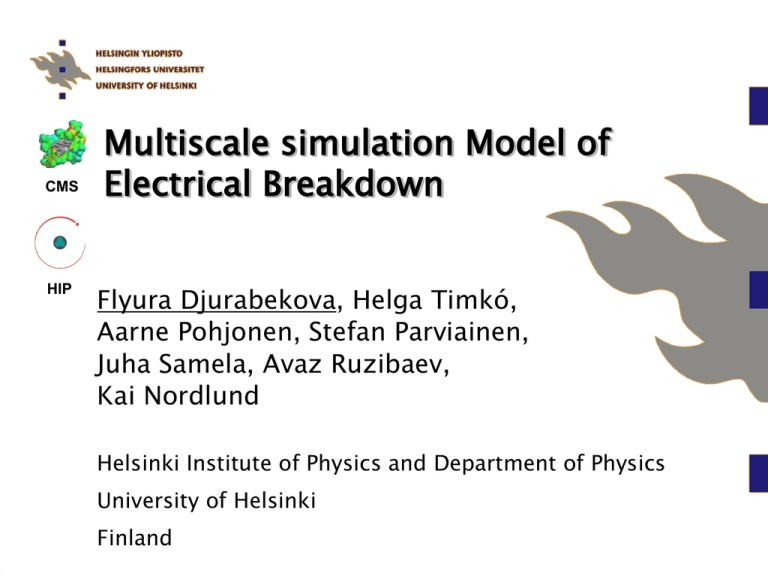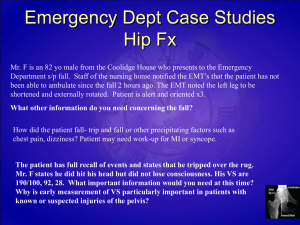BD_WSh_djurabekova - Indico
advertisement

CMS HIP Multiscale simulation Model of Electrical Breakdown Flyura Djurabekova, Helga Timkó, Aarne Pohjonen, Stefan Parviainen, Juha Samela, Avaz Ruzibaev, Kai Nordlund Helsinki Institute of Physics and Department of Physics University of Helsinki Finland CERN, Geneva Outline Motivation: why do we want to know? Multiscale model to approach the problem of electrical breakdown Plasma onset due to the external electric field Plasma simulation Surface cratering Accelerator Laborary, Helsinki Our understanding of electric field effect on metal surface Summary Flyura Djurabekova, HIP, University of Helsinki 2 Why do we want to know? Since the stone age sparks and arcs in shape of lightning were around. Frightening the human kind they eventually gave a spark for an evolution. People learned to make use of the sparks… The applications of sparks grew. When the electric field came into play, the short sparks and long maintained arcs could start their inestimable service. But, as in ancient days, we still suffer from lacking the knowledge: How does all start? Flyura Djurabekova, HIP, University of Helsinki 3 What is our object? Main goal: solve the puzzle of electrical breakdown in the CLIC components at rf-fields Current goal: look closely at “What happens if there is no magnetic component of the field yet?” (Electrostatic approach) DC setup at CERN for investigating electrical breakdowns Global goal: find the true mechanisms governing the material response on effect of electrodynamic fields Flyura Djurabekova, HIP, University of Helsinki 4 Electrical Breakdown in multiscale modeling approach Stage 1: Charge distribution @ surface Method: DFT with external electric field ~few fs Stage 2: Atomic motion & evaporation + Joule heating (electron dynamics) ~few ns Method: Hybrid ED&MD model (includes Laplace and heat equation solutions) ~ sec/min ~ sec/hours Stage 3a: Onset of tip growth; Dislocation mechanism Method: MD, Molecular Statics… Stage 3b: Evolution of surface morphology due to the given charge distribution O N S E T Method: Kinetic Monte Carlo Stage 4: Plasma evolution, burning of arc Method: Particle-in-Cell (PIC) Stage 5: Surface damage due to the intense ion bombardment from plasma Method: Arc MD Flyura Djurabekova, HIP, University of Helsinki P L A S M A ~10s ns ~100s ns 5 Stage 1: DFT Method for Stage 1: Charge distribution @ surface Method: DFT with external electric field charge distribution in Cu crystal Writing the total energy as a functional of the electron density we can obtain the ground state energy by minimizing it 1 (r1 ) (r2 ) E (r ) T (r ) Vex (r ) (r )dr dr1dr2 E xc (r ) 2 r1 r2 This information will give us the properties we want Total energy, charge states (as defect energy levels) Etot Energy convergence test Mesh cut-off Flyura Djurabekova, HIP, University of Helsinki 6 Stage 2: Hybrid ED&MD Stage 2: Atomic motion & evaporation + Joule heating (electron dynamics) Method: Hybrid ED&MD model (includes Laplace and heat equation solutions) Atoms move according Molecular dynamics algorithm, solving Newton equations of motion But in ED&MD hybrid code r F ; F V (ri ) mat F V (ri ) FL FC for surface atoms as due to the excess or depletion of electron density (atomic charge) Gauss law 0Eloc is applied to calculate the charges; Eloc is a solution of Laplace equation E 0.01 1 GV m FL + + + ++ + + + Thus, the motion of surface atoms is corrected due to the pulling effect of the electric field fiel Flyura Djurabekova, HIP, University of Helsinki 7 Stage 2: Partial charge induced on the surface atoms by an applied electric field Laplace solver E E0 Laplace solution 0 2 Mo (110) φ=const (conductive material) Flyura Djurabekova, HIP, University of Helsinki W (110) T. Ono et al. Surf.Sci., 577,2005, 42 8 Short tip on Cu (100) surface at the electric field 10 V nm-1 (Temperature 500 K) Flyura Djurabekova, HIP, University of Helsinki 9 Stage 2: Validation of the model Potential energy of an evaporating atom from adatom position on W (110) We validate our model by the comparison of potential energy of an atom evaporating from the W(110) surface with the DFT calculations from Unlike our model these are static calculations with no account for temperature and dynamic processes Flyura Djurabekova, HIP, University of Helsinki 10 Stage 2: What about electrons? Stage 2: Atomic motion & evaporation + Joule heating (electron dynamics) Method: Hybrid ED&MD model (includes At this high electric fields the field Laplace and heat equation solutions) emission is non-negligible Je phenomenon. ↑E0 Electrons escaping from the surface with the significant current will heat Emax the sharp features on the surface, causing eventually their melting. The change of the temperature Je (kinetic energy) due to the Joule heating and heat conduction calculated by 1D heat equation T ( x, t ) K 2T ( x, t ) (T ( x, t ))J 2 2 t CV x CV More details at Poster by Stefan Parviainen Flyura Djurabekova, HIP, University of Helsinki 11 Stresses due to the field While making the simulation of the atomic motion under an electric field (high values) we notice the significant expansion of the surface. This observation led us to think on the effect of the pressure. The pressure can be not only due to the applied filed, but also of a different nature. However, redistribution of any present stresses may be caused by the field → Fel STRESS =0E2/Y Flyura Djurabekova, HIP, University of Helsinki + + + + + + + + 12 Step 3a: Are tiny whiskers possible? Stage 3a: Onset of tip growth; Dislocation mechanism Method: MD, Molecular Statics… There is a number of mechanisms which might make the dislocations move coherently causing a directed mass transport, thus forming a whisker growth. We are looking for the most probable at our condition. Talk by Aarne Pohjonen in the afternoon Flyura Djurabekova, HIP, University of Helsinki 13 Is it only cohesive energy we can see a correlation with? The dislocation motion is strongly bound to the atomic structure of metals. In FCC (face-centered cubic) the dislocations are the most mobile and HCP (hexagonal close-packed) are the hardest for dislocation mobility. Flyura Djurabekova, HIP, University of Helsinki 14 Step 3b: Kinetic simulation of surface diffusion under the electric field Stage 3b: Evolution of surface morphology due to the given charge distribution Method: Kinetic Monte Carlo We initiate new activity to simulate long term processes (surface diffusion, electromigration) Energy barriers calculated by ED&MD simulation will be introduced into KMC code to assess the probability of the atom/defect cluster jumps V Ea 0 exp kT Time is calculated according to the residence-time algorithm Flyura Djurabekova, HIP, University of Helsinki 15 Stage 4: plasma formation and evolution Stage 4: Plasma evolution, burning of arc Method: Particle-in-Cell (PIC) 1d3v electrostatic PIC-MCC code developed for plasma simulations ~ 4-6 kV r=1 mm Resolving the main stream of plasma Areal densities of physical quantities To have a direct d=20 μm Cu Next talk by Helga Timko Flyura Djurabekova, HIP, University of Helsinki comparison with experiments, we adjusted simulation parameters to the DC setup at CERN 16 Step 5: Huge fluxes (1024 ion cm-2 sec-1) of accelerated ions cause severe surface damage Stage 5: Surface damage due to the intense ion bombardment from plasma Method: Arc MD Ion fluxes leave rims of peculiar shape Flyura Djurabekova, HIP, University of Helsinki 17 Cu (100) bombarded by DC arc ions: Φ = 5.66x1024 cm-2 sec-1, E ≃ 8 keV MD simulations of surface bombardment on a given area A Ion flux and energy distribution corresponded exactly to that from PIC simulations! Flux of ~1025 on eg. r=15 nm circle => one ion/20 fs!! Flyura Djurabekova, HIP, University of Helsinki 18 Comparative simulation of arc ion bombardment and thermal deposition of energy (no ions) PIC energy distribution Flyura Djurabekova, HIP, University of Helsinki Thermal heating only 19 Step 5: Plasma-surface interaction Crater formation The comparison of simulated and experimental craters is encouraging (scaling law is necessary at the moment) [H. Timko, F. Djurabekova, L. Costelle, K. Nordlund, K. Matyash, R. Schneider, A. Toerklep, G. ArnauIzquierdo, A. Descoeudres, S. Calatroni, M. Taborelli, and W. Wuensch, Phys. Rev. B (2010), accepted Flyura Djurabekova, HIP, University of Helsinki 20 Step 5: Mo as a new material to investigate the craters Flyura Djurabekova, HIP, University of Helsinki 21 Crater profiles: Mo cluster bombardment E = 8 keV/atom N = 100 N = 1000 zoomed 200% Macroscopic saturation level N = 5000 Flyura Djurabekova, HIP, University of Helsinki 22 Summary Multiscale modeling gives clear insight to the ongoing processes on the surface at high electric fields We suggest a probable scenario of triggering of a tip growth: Voids may serve as efficient source of dislocations for the mass transport to the surfaces! Modeling of DC electrical breakdown can shed the light on the metal surface response to the electrical field effect also in case of rf electrical breakdown Simulation of craters created by formed plasma reveals the dependence between energy deposition and crater shape. Flyura Djurabekova, HIP, University of Helsinki 23 Flyura Djurabekova, HIP, University of Helsinki 24





